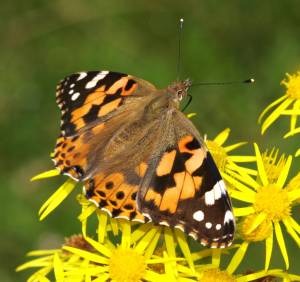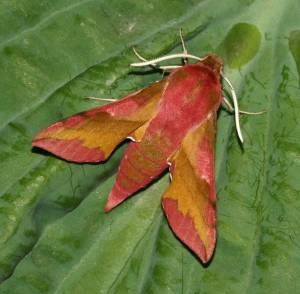Dr Phil Smith’s Wildlife Notes
May 2009
May 2009 will go down in history for the most spectacular insect invasion in living memory. From around the middle of the month, millions of Painted Lady butterflies poured across the English Channel into southern England. By about 25th they were arriving in our region. On 29th John Dempsey counted 200 per hour flying along the shore at Southport and there were a dozen or more in just about every Formby garden. As explained in the national press, these fast-flying, hardy butterflies originated in North Africa where high rainfall encouraged rapid breeding. Their caterpillars feed mainly on thistles, so we can expect locally bred butterflies to appear in July and August.

My friend Trevor Davenport has been light-trapping moths in his Freshfield garden and phoned me on 31st, having caught a Small Elephant Hawkmoth. I was round there like a shot as, despite being interested in moths for 50 years, I had never seen this species which is real beauty. According to Graham Jones, the Wildlife Trust’s Reserves Officer and an expert in these insects, the Sefton Coast is one of Britain’s moth hot-spots. Trevor has had several notable species already, although he only started trapping last autumn.

The volunteers of the North Merseyside Amphibian & Reptile Group have been studying Sefton’s endangered Sand Lizards for several years, perfecting techniques for finding them and recognising the unique colour-patterns of different individuals. The good news is that the population is in a far healthier state than was thought a few decades ago, the most recent estimate being 1000-1500 adult lizards. Recently, I had an exciting message to the effect that the group had just found a tiny remnant population on Hightown dunes south of the River Alt, an area with no Sand Lizard records for at least 30 years. There is a plan to introduce, over the next few years, captive-bred youngsters to both Hightown and the Wildlife Trust’s Freshfield Dune Heath reserve.
The Cheshire ecologist, Dr Hilary Ash, came to see the Formby Black Poplars on 28th. She confirmed that we have at least five different types: three hybrids, the Native Black Poplar (Populus nigra ssp. betulifolia) and what may be a French form of the latter. Further research is underway to finalise identifications of these trees, which are of considerable historic interest.
A guided visit to Altcar Rifle Range on 15th was rewarded with the amazing sight of over 21,000 of the rare and beautiful Green-winged Orchid (Orchis morio), the largest colony of this plant in the north of England. Two new plants for the ranges were Spurge Laurel (Daphne laureola) and Mediterranean Spurge (Euphorbia characias), both being garden-escapes. With friends, I also added five new species to the Birkdale Green Beach plant list, which now stands at 281.
Bird highlights this month included the first Pallid Swift for North Merseyside and Lancashire at Seaforth/Crosby, which kept reappearing for several weeks. Also popular were the parties (or “trips”) of Dotterels which alighted on Plex Moss between 5th and 10th. Unfortunately, these colourful birds were frequently disturbed by crowds of birders, some of whom failed to observe the first rule of mossland bird-watching: “stay in your car!”
